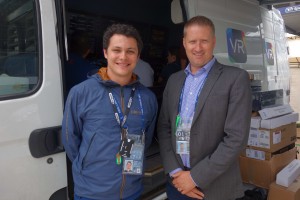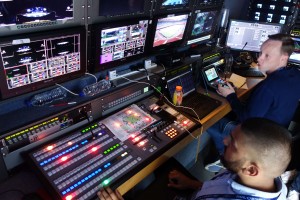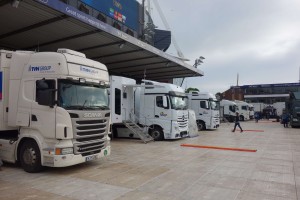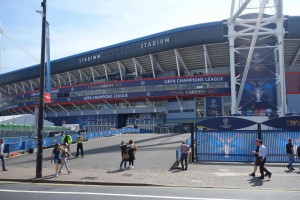Live from Cardiff: World firsts as BT Sport blazes innovation trail for CL Final
The UEFA Champions League Final is the biggest one day event in the sporting calendar. The 2017 showpiece was held at the National Stadium of Wales in Cardiff on June 3 and as domestic rights holder, BT Sport was host broadcaster. Given this opportunity, BT Sport sought to make the final available to the widest possible audience and to bring people closer to the action by deploying a number of world-first innovations.
The HD host broadcast camera coverage comprised 47 cameras including Spidercam, goal rail cameras and Heli tele. BT Sport 2 was made available free to air in SD and HD on platforms including BT TV Freview, Virgin, Sky, bt.com web site and the BT Sport App.
The game was produced in Ultra HD 4K with a further 22 cameras and Dolby Atmos immersive audio and delivered to BT TV customers on the BT Sport 4K UHD channel.
BT also partnered with social media platform YouTube. The collaboration included the Ultra HD programme so the best 4K pictures were available on smart televisions and 4K streaming devices such as PS4 and Chromecast.
BT Sport and UEFA, working closely with supplier Deltatre, developed and produced live 12-camera VR coverage with innovative features not seen previously including live replays and in-match graphics. Many of the tools required to deliver this coverage were developed in partnership with broadcast specialist MOOV. BT Sport also made the 4K VR 360° produced feed available on YouTube and it was promoted within Google’s Dreamcast VR environment on June 3.
As part of the partnership with Dolby, a special version of the game was broadcast to the Ray Dolby Theatre in London’s West End. This Ultra HD, HDR and Dolby Atmos production was viewed on the only laser cinema screen in the UK to an invited audience of press and guests.
Partnerships and collaborations deliver innovation
A broad canvas of collaboration, right across the production, delivery and consumption spectrum was key to BT Sport’s innovations for the Champions League final in Cardiff. Using its UHD truck OBX, Arena worked with BT Sport on two world firsts in preparation for this weekend: simulcasting in UHD and HD over an IP backbone, plus live coverage of the Premier League and the FA Cup in Dolby Atmos.
Axon’s Synapse signal processing technology was deployed by BT Sport to streamline its 4K production setup. The National Stadium of Wales joined BT Media & Broadcast’s Terabit next-generation fibre-based TV Outside Broadcast network which links football grounds across the UK to BT Tower and transports HD video uncompressed from venues to production hubs.
BT Technology Service & Operations worked with BT Sport to provide free access for the game on YouTube and the BT Sport app/website, plus worked with YouTube to deliver Virtual Reality and 4K streams of the game, as well as working with partners to create a new VR App. From an OB perspective, the team delivered a network to carry HD and Dolby Atmos UHD TV feeds back to the BT Sport studios in London from Cardiff.
Deltatre’s Diva solution enhanced BT Sport’s interactive digital video player by allowing users to replay key events, choose multiple camera angles and access stats such as passes and distance covered. Ericsson provided a playout of the BT Sport channels in UHD and HD and also supported BT Sport with a range of activity including supplying a free to view 4K simulcast of the final to YouTube and UHD with Dolby Atmos on BT TV.
EVS’ XT4K live production servers were on-site in Cardiff to ingest UHD-4K camera feeds to help create compelling live slow motion replays. In addition, BT Sport made multi-angle replays available to subscribers of its mobile app through EVS’ cloud-based C-Cast content distribution platform.
LiveLike developed the VR platform that supported the BT Sport VR app during the match, providing solutions allowing fans to choose between different 360 camera angles or a live director’s cut which automatically moved between vantage points around the stadium.
MOOV developed a range of software and apps to support BT Sport’s VR offering such as driving 4K VR graphics and its MOOV360 Commentator app which provides the user with a live VR feed without the need of a VR headset. UEFA conducted a 12 camera VR shoot – the biggest ever for a live VR stream according to Nokia — utilising Nokia’s OZO Live and OZO+ live VR broadcasting solution.
RT Software’s augmented reality (AR) technology allowed viewers to see an intricate night-time 3D map of the cities hosting games on UEFA Champions League match-nights spread across the BT Sport studio. SAM helped BT Sport to premiere the world-first UHD HDR full scale production with Kahuna’s FormatFusion4. Kahunas and Kula were also deployed across Cardiff, Stratford and Soho to provide HD and UHD productions and transmission. SAM’s Livetouch replay solution formed part of BT Sport’s overall VR activity.
Sony supported the live HDR production with its SR Live for HDR workflow. BT Sport’s 4K and HDR content utilised a range of Sony UHD/HDR tools, such as established HDC-4300 cameras to specialist equipment.
Telegenic Commercial Director Eamonn Curtin told SVG Europe, “We had four trucks in Cardiff —
T19, T25, T23 and T21 — covering four feeds including HD, 4K and HDR following the successful delivery of more than 130 live simulcast HD/4K productions for BT Sport this season. We also had a fifth truck T16 being used by UEFA for their FANtainment and Unilateral feeds. In total we had 50 full time staff engineers on site making it all happen, which shows the strength in depth we have as a company to keep delivering large scale events world wide.
“It was great to take the experience we have gained working on many Euro Final tournaments since 2008 for UEFA, our technical expertise in 4K and HDR and use these to deliver BT Sport’s biggest event to date for multiple formats. It was not only a fantastic game on the pitch but also a faultless one behind the scenes,” said Curtin.
Timeline provided its outside broadcast truck UHD 1 and staff to produce the sub-mix element for BT Sport. Timeline supplied BT Sport with UHD cameras, lenses, EVS equipment and edit facilities.
High Dynamic Range: More than proof of concept
“We’re excited,” said BT Sport Chief Engineer Andy Beale in Cardiff ahead of the match. “This is a genuine Dolby Atmos, 22-camera, HDR-covered final with studio presentation also in HDR. All of our studio cameras are HDR. We chose the Sony cameras for HDR, the Spidercam is HDR, Railcams are HDR: the Sony head gives us those two outputs so we can get genuine HDR.
“In the production space we’re SLog-3, and then we convert into PQ and HLG as it walks out the door. We’re cutting a PQ master and an HLG master and sending them back to the studio and inserting advertising that will be upconverted from SDR to HDR, with channel logo, and then that’s passed on to our trial channel and onto the Dolby Theatre — to be seen on the only HDR laser projector in the UK. That’s why we chose that venue for the demo.”
Sony Europe Head of Sports Business Development Mark Grinyer told SVG Europe, “BT Sport is using our HDRC-4000 units here, and various monitors and bits and pieces to be able to manage the HDR. They’re using S-Log3, BT.2020 colour space for production and then obviously running to their delivery format. We’ve been testing HDR with BT Sport for over a year now, so this is the culmination event. They’re pushing the envelope – in fact both themselves and Sky are pushing in that area. For the [next] World Cup we’ll be offering broadcasters HD/HDR overlay, and it’s great to see that coming from here.”
“It’s more than proof of concept,” said Jamie Hindhaugh, BT Sport Chief Operating Officer. “What we are doing on Saturday from a production aspect is declaring that we are HDR-ready.
“We will be asked why we have gone down the PQ route. The main reason for that is that all of Netflix and Amazon’s HDR is PQ, so we think that’s where the consumer market is going to go. I know the BBC is looking at Hybrid Log Gamma: we can obviously do HLG – in fact we’re doing both on Saturday – but if I had to put money on it I’d go with PQ, longer term, because of the amount of content that’s coming out in that format.
“On Saturday there are around 50 people who will be experiencing a real world first, given the fact that we will have 4K HDR and Dolby Atmos in a specially constructed cinema with that Atmos surround in there, all totally live. That’s the big message; it’s live. HDR has been around for a long time, but not in a live environment.
“When we roll it out commercially — bearing in mind we were a year ahead of anyone else in Ultra HD — I don’t think there will be a big rush for HDR because there are still not that many TVs sets available,” said Hindhaugh. “The consumer messaging has to be really clear about what this is, because there’s a danger of unpicking the whole market. People might think, ‘well what’s the point of buying a new TV if it’s all going to change again in six months?’ The TV market is going there, but my gut is that it’s not next year but the year after that HDR becomes [prevalent].”
“For live sport, HDR is extremely important,” said Andy Beale. “We saw it last Saturday at Twickenham for the Rugby Premiership final, our last rehearsal for both VR and HDR. On the HDR pictures, there was no need to rack the cameras. Normally the racks engineer on the SDR is adjusting as the ball goes in and out of the shaded area of the pitch. But last Saturday we were saying ‘leave it alone, it’s fine. It looks great!’ HDR went live right through to the Dolby Theatre and to the set top box.
“We saw in Twickenham that with HDR, the pictures jump out of the screen. You get that 3D effect that people have craved, with improved contrast, and detail on the shirts.”
“Dolby Atmos has been phenomenal,” added Hindhaugh. “When we launched Dolby Atmos – and bear in mind there are not that many receiver kits in the UK – our 4K viewing audience went up by 25%. There is perception around quality: it’s not just about Dolby Atmos, it’s the perception that this is the best picture and the best sound. People are getting it.
“Dolby Atmos for me has probably been our biggest innovation – probably above 4K actually. It’s the biggest innovation in sound for ten years, since 5.1 came out. We’re really proud of it,” he said.
“HDR with 4K finishes the 4K story. I think our 4K pictures are phenomenal. For me it’s the trio; 4K, HDR and Dolby Atmos. We’ve got an editorial strategy to be at the heart of sport; so if you’re not at the event, you can feel like you are.”
Inventing a live VR production workflow for the Final

MOOV Project Manager Laurie Beamont and BT Sport Chief Engineer Andy Beale by the VR production van in Cardiff
“For me, you’d never want to watch a full game in virtual reality,” said Hindhaugh. “Really. We’ve got a much longer strategy, about how we incorporate the key events within our workflow. But we still want to give people the option: a curated feed, with 12 cameras and dedicated commentary, live VR graphics and live replays, meaning you can actually sit there and watch the game. I don’t think anyone has done live VR graphics in this way, with the virtual Jumbotron. It’s incredible. And it isn’t a stunt. We already do VR for boxing, and that’s going down really well.
“This isn’t an accompaniment. I don’t think it’s even a second screen; I think it’s a third screen. You’ve got your main 4K picture, then your stats and twitter feed and what have you — and then you’ve got your other device that you are engaging with [in VR]. With the delay that’s there, if you’re watching a goal go in you’ve got time to pick up your phone, get the VR up and you almost curate your own replay. It’s bringing two worlds together.
“VR has been, to some extent, the emperor’s new clothes. Iso camera; watch five minutes; and bin the headset. The way it can go is about treating it as another broadcast medium and curating content for an audience. That’s our job. That will make sure you get the best view, the best experience,” said Hindhaugh.
“We started with three cameras in Munich in Germany at [Champions League] the group stages, and this is where we’ve got to now with a 12-camera mix and with all the tools you can see here,” added Beale.
“The coding is all from MOOV. Our final test in Twickenham last weekend was with eight cameras, and now we go to twelve here. We have a great relationship with Olivier Gaches and his [Digital Broadcasting] team at UEFA, they’re a joy to work with. We’ve worked really closely in making decisions and moving VR forward. We think it really works.
“Four trucks are involved here in our VR production. The Deltatre VR vans are capable of doing four cameras each, and there are two of those vans. And we’ve temporarily rigged up another four cameras. We think the way forward is a blend of being able to choose a position and offering a curated experience – because a director still knows best.
“What we’re producing for the world is a BT Sport feed which consists of 12 live cameras the director can choose from; live graphics; live replays; and with commentary. It’s a ‘TV-esque’ experience within the VR world. You can choose from eight iso angles, or the BT Sport-produced feed. It works both with goggles or magic window, where you touch and scroll or pan and tilt.
“Deltatre manage the cameras out on the pitch and do the stitching. They then hand those feeds to us in our van next door, where we do the live production, with BT Sport’s VR Producer/Director Vijay Patel.
“In the van it looks like a TV production gallery,” said Beale. “With the Blackmagic Design ATEM vision mixer, Vijay is cutting between cameras. Nari Tootoonche, VR Designer from MOOV, is doing the live graphics – we’re very excited about this. In conjunction with MOOV we’ve developed some special tools to do live graphics in the 3D space. We’re also using the SAM Live Touch server solution, with ten channels of server record. And it’s full 4K.
“With one SAM controller you can get to all ten angles. Ten of those 12 cameras are iso recording into the server and we can turn them around for replays. And then we’ve got a sound desk to do mix and commentary. This is a full VR 4K operation.
“How does a commentator and producer get to see what they’re working with in VR? Again working with MOOV, we’ve developed some special live tools to enable this. We developed a commentator tool, for the commentary van, so the commentator can scroll through – just like you would do with your phone – to look around the 3D space.
“We’ve also built a Region of Interest tool: on the replays we can spin the action of interest to be in the middle, so if the manager is celebrating wildly off to your left, we can spin it before we roll it, so it’s actually appearing in the same frame you’re looking at. We can rotate the replay to be where we want it in the 360,” said Beale.
MOOV Project Manager Jamie Beamont told SVG Europe, “It’s a very exciting project. It’s happened rather quickly, and BT Sport has been very receptive. Every test that we’ve done to this point, we’ve been offering more and more.
“We’ve got a lot things that we have to harness to align with the UEFA on-screen brand. VR graphics
are slightly different because they are there all the time. Part of the challenge was, how do we apply these graphics within this world and make them effective for the audience? Do you have them always in front of the viewer or do you make the viewer look for them?
“Our developer Nari Tootonche has built the system for us, using the Unity engine. He developed the control and the environment where graphics live, and has had a good dialogue over many weeks with BT’s Vijay Patel on what works and what doesn’t.
“We have live audio as well, and a live commentator, Seb Hutchinson, who sits in a separate van. We’ve developed a commentator tool that allows him to see the VR without wearing goggles. He can use it in a touchscreen format where he can rotate around, and he will commentate with VR in mind, mentioning things that are beneficial to the viewer,” said Beamont.



